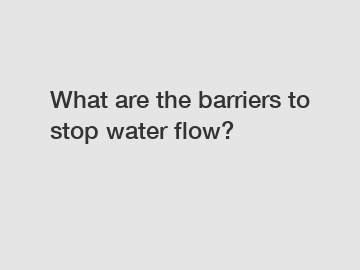What are the barriers to stop water flow?
What are the barriers to stop water flow?
Water flow is a natural phenomenon that can be powerful and relentless, creating a need for barriers to control and mitigate its impact. These barriers serve as important tools in managing water resources and protecting communities from potential flooding disasters.
One of the most common barriers to stop water flow is known as a dam. Dams are large, man-made structures built across rivers or streams to control the flow, store water, and generate hydroelectric power. They work by creating a reservoir on one side and regulating the amount of water released on the other. By controlling the water flow, dams can prevent flooding downstream and ensure a steady supply of water for various purposes such as irrigation, drinking water, and industrial use.

Another barrier to stop water flow is the levee. Levees are earthen embankments constructed parallel to rivers, streams, or coastlines to prevent flooding by confining the water within a designated channel. They essentially act as walls that raise the water level and prevent it from spilling over into surrounding areas. Levees are commonly used in low-lying regions that are prone to flooding, providing protection to urban areas, agricultural lands, and critical infrastructure.
In addition to dams and levees, there are other barriers that can be used to manage water flow. One example is the flood gate or weir. These structures are installed in rivers or canals and can be opened or closed to regulate the flow of water. Flood gates and weirs are often used in conjunction with dams or levees to provide additional control and flexibility in the management of water resources.
The need for barriers to stop water flow stems from the inherent risks associated with uncontrolled or excessive flow. Flooding can lead to devastating consequences, including loss of life, destruction of property, and disruption of essential services. By implementing these barriers, authorities can effectively manage and mitigate the impact of water flow, safeguarding communities and their livelihoods.
Moreover, the significance of these barriers goes beyond immediate flood control. Dams, for example, provide a sustainable source of clean energy through hydroelectric power generation. This helps reduce reliance on fossil fuels, mitigates climate change concerns, and promotes a transition towards renewable energy sources.
In conclusion, barriers such as dams, levees, flood gates, and weirs play a crucial role in stopping water flow and managing its impact. These structures enable the control of water resources, prevent flooding, and provide various benefits such as renewable energy generation. Investing in the development and maintenance of such barriers is essential for the protection and sustainable management of water systems worldwide.
Contact us to discuss your requirements of water filling rubber dam, sewage Containerized Treatment Plant supplier, Containerized Sewage Treatment Plant. Our experienced sales team can help you identify the options that best suit your needs.
359
0
0


Comments
All Comments (0)